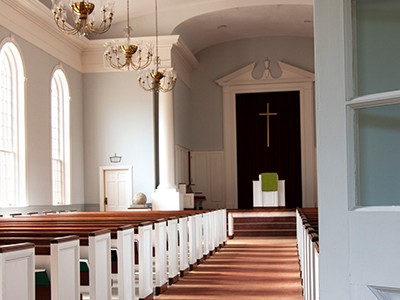Do you have a handbook for the security team at your church? If not, then you might not be ready for any of the many health, safety, and security events that can affect any large, public organization including a church. As part of security planning, your church needs a security manual.
That’s where Solink comes in. Here, you’ll find everything you need to draft a church security manual, including some helpful templates.

A church security manual is the living document at the center of the church’s security plan. It includes all of the information gathered and systems put in place at your church to prevent safety and security incidents when possible and react to them effectively when necessary.
What is a church security team handbook?
A church security team handbook is often just a different name for a church security manual. However, for large churches with greater security needs, including trained security personnel, the security team handbook can be a separate document.
In this case, it will include the names of team members, their job titles and roles, and so on. It’ll also describe the ongoing training plan that security personnel must follow. Finally, the church security team handbook can make explicit the types of interventions authorized within a church.
Why does a church need a security manual?
Churches, as well as synagogues, temples, mosques, and other houses of worship, are not immune to crime. Crime is also only part of the safety and security threats facing churches.
A church security manual is the basis of all the procedures put in place to keep your community safe. The security manual for your church also provides accountability, as it states exactly what you are doing to keep your members safe and why you have chosen those policies.

What threats do churches face?
Churches may be confronted with many threats to the health and safety of their community. Here are just some of the crises that your church should consider when writing a church security plan:
Security threats in churches:
- Alcohol-related violence, if alcohol consumption occurs during social events, fairs, etc.
- Bullying in the youth ministry, daycare, or school.
- Violence during counseling sessions.
- Active shooter events or terrorism.
Health threats in churches:
- Medical emergencies during services (e.g., heart attacks).
- Injuries during church sporting events, in the daycare, etc.
- Car accidents in the parking lot.
Property threats in churches:
- Arson attacks (especially for older, wood-built churches).
- Smash-and-grab thefts from cars in the parking lot.
- Stealing or damaging irreplaceable artwork.
- Theft of cash tithes.
- Vandalism.
Which technologies should churches consider to improve their security?
There is a lot of variety in the structure of churches. Depending on the size of your church, the age of the building, the location of your church, the local crime rate, and what services you offer, the security needs of your church will be different.
For example, if your church has an associated school, then you’ll have school security system requirements as well.
The following is a list of security technology you may need at your church:
- Security cameras: Security cameras are a key piece of security infrastructure for any organization, including churches. Most churches have indoor and outdoor security needs and will likely require several different types of security cameras to cover their entire property.
- Video analytics: Cameras offer great security coverage. However, they can be a passive solution, and if you aren’t alerted to an issue, you may never see the event. Most security camera systems also require you to access the video footage locally on the CCTV system. Video analytics makes the cameras a proactive security system with remote monitoring capabilities.
- Data storage: Some cameras have data storage in them, but it is usually limited. Most systems require a DVR or NVR to manage local storage. Other cameras store directly to the cloud. Solink offers a hybrid cloud and local storage solution that gives you the accessibility of cloud video storage with the robustness of on-premises storage.
- Door and window alarms and sensors: Intrusion detection is a key component of your security perimeter. The security perimeter is the wall of defense around your property. Alarms and sensors that can tell when a door is opened is one way to achieve a strong security perimeter around a building.
- Video alarms: Solink’s Video Alarms is a great way to leverage your existing cameras for further security benefits. Video alarms work by detecting motion during specific periods of time in a designated location. Instead of a door alarm that alerts authorities automatically when a door is opened, video alarms can detect motion inside and outside the door and then notify the owner of the alarm. Solink offers self-serve and monitored video alarm products to meet the needs of your church.
- Access control: Access control panels allow entry to church facilities by authorized users who input a code into a panel. This allows church management to both keep unauthorized users out and know who has entered a building in the case an event occurs.
How to develop a church security manual
Writing a church security manual is part of church security planning. Here are some points to keep in mind when developing a security manual for a church:
- There are safety regulations that need to be followed, for example locking doors from both sides during services would pose a fire hazard.
- The church safety manual needs to be comprehensive. It should address health, safety, fire, accident, and parking lot collision incidents as well as violent crimes (domestic violence, physical altercations, mass shootings, terrorism, and so on) and non-violent crimes (vandalism, break-ins, robberies, and so on).

- There are legal issues that need to be addressed, for example whether armed security guards are permitted.
- Working directly with first responders (police, fire, and EMTs) will yield better results than writing a church security manual alone.
- Most churches have highly skilled members who could help in this process, including members of the military, police officers, firefighters, doctors, and nurses. Surveying the membership and asking for input will both provide a better result and lay the groundwork for community buy-in to heightened security measures at your church.
- This is not a one-time process. Church security manuals and/or church security team handbooks should be reviewed and updated regularly.
- You should write using clear, precise, and simple language. This prevents confusion and misunderstandings that might lead to issues in the future.
What should be included in your church security manual?
Here are the recommended sections to add to your church security team handbook. The following is a minimal church security manual template. In the following sections, we provide some other church security templates and examples.
1. Purpose
Why are you writing this church security manual?
This defines why you are writing a security manual, as well as why you are undertaking the improvement of your church security in general. Be specific and focus on the benefits this provides to the church membership.
2. Method
How are you going to improve security at your church?
This section details what measures will be taken to improve church security, including the creation of a church security team, the purchase of security and first aid equipment, and ongoing training.
3. End state
What is the goal of improved security for your church?
This defines what you would like to accomplish with your church security measures. For example, you may want there to be members working the doors at every service, someone with first aid training at every event, and monthly security meetings for continuous improvement.
4. Authority
Who authorized the church security manual and what authority is conferred by the manual?
This section has two parts. First, it should state under what authority the church security manual was published. For example, it may state that the senior pastor and church council both approved its creation.
Second, it should stipulate what power is being granted by the manual. For example, it might state that the church security manual is authorizing the creation of a church security director and church security team who will independently ensure the safety of the church on the basis of monthly reports to the church council.
5. Security team
Who is involved in church security management and operations?
This section should detail all the roles involved in church security. This includes the church security director and church security team, as well as who they report to and what oversight is required.
6. Training
What are the training needs of your church security team?
Church security requires some level of initial training as well as ongoing training. For example, you would not want armed security guards who have not had substantial firearms training, but firearms also require ongoing training to maintain proficiency.
Similarly, there will need to be some initial first aid training, training on new equipment as it is purchased, and ongoing training to keep skills from going rusty for anyone involved in health and safety management.
7. Team deployment
When do you need to activate your church security team and how?
This section tells you when you need to have security personnel, how many, and why. If your church does multiple weekly services, but one is much larger than the others, this is a place to stipulate the need for a larger security presence during that service.
Similarly, if you have special events and festivals or provide your church space for outside events (such as weddings), then you should define the security needs on these occasions.
8. Team duties
What does each member of the church security team do?
This section details what the church security director does, as well as the individual roles of other members of the team. These roles can be permanent or on a rotation. For example, you might have interior and exterior security roles during weekly services. In the first case, those roles would be set, while in the second members would rotate between interior and exterior security details.
It’s also important to mention how often meetings will take place and the ongoing requirements to maintain membership on the church security team. For example, members may be required to join the security detail for three services per month, do at least two hours of training per month, and attend nine of the monthly meetings per year or be removed from the team.
Finally, if your church security team has a dress code, be sure to mention it here.
9. Equipment
What equipment will be provided by the church?
We discuss above what kind of security equipment your church may need. Smaller items, such as two-way radios or safety vests, can also be included here. If members need to buy any equipment themselves, or if they should purchase the item of their choice and be reimbursed, this should also be included.
If your security system requires specialized training, then you should mention that here. If not all members of the church security team are authorized to access some security equipment, then you should list the authorized users here as well.
For example, Solink allows an unlimited number of authorized users with varying privileges. This might mean that the senior pastor and church security director have access to all internal and external security cameras while other members of the church security team can only view external cameras and those facing the entrances.
10. Safety surveys
Your church security director should be performing monthly audits of the health and safety status of your church. This includes documenting any Occupational Safety and Health Administration (OSHA) violations or instances where security cameras have been obstructed or gone offline.
Solink can help with this. Solink provides notifications whenever a camera is occluded or offline. In addition, health and safety audits are easier using the Solink platform. You can even set up notifications for blocked emergency exits and other common OSHA violations with our motion search capabilities.
To find out how Solink can help keep your church safe and secure, sign up for a demo today.
Church security manual templates
The church security manual template provided above gives you an idea of what should be included. However, if you’d like to see a completed church security manual, the following templates are great examples that you can implement in your church.
- My Church Security: This church security manual template is concise and provides bullet points for each recommended section.
- Template.Net: Temple.Net offers five church security manual templates
Church security manual examples
The following are fully realized church security manuals:
- First United Methodist Church of Clinon, MS
- Church Safety and Security: A Practical Guide
- Heritage Universalists Unitarian Church
- Church Safety And Security Policy Manual by Jim Baker
Looking at these church security manual examples, it is clear that they vary in some very obvious ways. First, some are written in plain English while others are very legalistic. Second, the level of detail varies remarkably from one church security manual example to another.
Finally, here are two websites that provide helpful tips on how to draft a church security manual:
Church security manual FAQ
Here are some frequently asked questions about church security.
How do you organize a church security team?
As part of your church security planning, you should assess the current security needs of your church. Then, with the approval of church leadership, build a team around the church security director from membership that meets the security needs of your church.
How can church security be improved?
The first step in improving church security is realizing that you are currently not meeting the security needs of your community. From there, you should build a security plan for your church, assign the roles to your church security team members, and purchase any needed infrastructure, such as security cameras and video analytics.
Do churches have security?
Most churches have some level of security. This will vary depending on the size and age of your church, its location and local crime statistics, any local laws or health and safety regulations, and the types of services you provide to your community.
How do you secure a church?
Churches can be secured in many ways. Access control panels, intrusion detection, security cameras, and a video analytics platform are common church security infrastructures.
How do you develop a church security manual?
The easiest way to develop a church security manual is to start with a template. If you have a step-by-step church security plan in one hand and a church security manual template in the other, then you will find the entire process very achievable.
What sections should you include in your church security handbook?
Solink’s church security handbook template includes the following sections:
- Purpose
- Method
- End state
- Authority
- Security team
- Training
- Team deployment
- Team duties
- Equipment
- Safety surveys
Put Solink on your church security team
Solink connects the people and tools involved in your church security plan in one convenient app. You can oversee the safety of your property and community on your laptop or mobile device from anywhere. Our customer success team becomes part of your church security team so that you always get the most out of the platform.
To see where Solink fits in your church security manual, sign up for a demo today.
